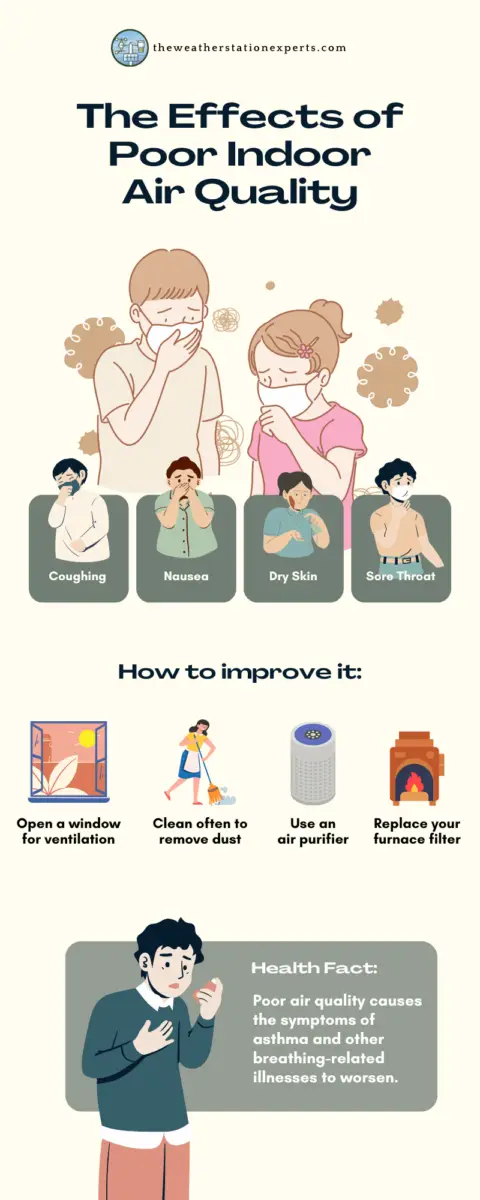Although outdoor air quality gets all the attention, monitoring your air quality indoors is essential too. Indoor pollutants pose a health risk if not monitored properly. Thankfully, indoor air quality monitors provide all the information you need to detect poor air quality. It might be a good choice when running an air purifier, or it’s time to open the windows for some fresh air.
If you or someone you know suffers from cardiovascular or respiratory problems, indoor air quality monitors are essential for maintaining a healthy living space. Read on to learn more about who should buy an indoor air quality monitor and why you should regularly test air quality in your home.
Infographic
We’ve distilled the information below down to an easy-to-understand infographic for our subscribers. For performance reasons, a lower-quality image is shown on this page. To save the full-size image to your computer, click the “download” button below the infographic.
What makes indoor air quality bad?

The accumulation of particulate matter in an indoor space makes your home’s air quality poor. The small liquid and solid particles in the particulate matter include acids, metals, organic chemicals, and dirt or dust. Common sources of indoor air pollution include:
- Combustion activities (cooking, fireplaces)
- Building materials and furnishings
- Household cleaners and other cleaning activities
- Mold and mildew outgrowths
- Central heating and cooling systems
These sources’ impact on indoor air quality depends on the quantity of particulate matter emitted and whether these emissions are produced continuously or intermittently. For example, a significant mold outgrowth releases many spores and impacts air quality. Conversely, a minor mold outgrowth removed quickly has little impact on air quality.
Who is Most At Risk from Bad Indoor Air Quality?
Bad indoor air quality puts specific groups of people at an increased risk for health complications. The people most at risk from bad indoor air quality include:
- Babies and children
- People with cardiovascular or respiratory problems
- Older adults
Respiratory conditions like asthma render people more vulnerable to indoor air pollution. Additionally, bad indoor air quality exacerbates symptoms like difficulty breathing and shortness of breath. In cases like these, buying an indoor air quality monitor is often a necessary health expense, especially if there are already recurring issues with indoor air pollution.
I’m Healthy. Can Bad Indoor Air Quality Make Me Sick?

Regardless of your health status, poor air quality can make you sick. Acute exposure to high particulate matter concentrations can cause difficulty breathing, throat and eye irritation, and chest pain.
- Lung damage and potentially lung cancer
- Throat irritation
- Chronic bronchitis
- Irregular heartbeat
- Increased fatigue
Knowing your home’s air quality is wise, regardless of your health status. Even if you are healthy and at a lower risk of contracting a respiratory illness, bad air quality can make you sick after prolonged exposure. Fine particulate matter (PM2.5) poses the greatest risk for potential health effects since these particles can enter the lungs and possibly the bloodstream.
What Does a Good Indoor Air Quality Monitor Measure?
Most air quality monitors measure PM2.5 and PM10, but good indoor air quality monitors measure less common air pollutants. Some even include a humidity and temperature sensor and measure air pressure. High indoor humidity can cause mold, and if your home’s temperature is warm enough, it can accelerate this growth. Most indoor air quality monitors measure a wide variety of different airborne pollutants, including:
- Ultrafine particles (PM1)
- Total volatile organic compounds (VOCs)
- NO2 (nitrogen dioxide)
- CO2 (carbon dioxide)
- Carbon monoxide
- Radon levels
- Pollen and other allergens
Although most particulate matter is of the PM2.5 and PM10 variety, PM1 is more dangerous than PM2.5 since these particles are smaller (less than one micrometer). These ultrafine particles can easily travel from the lungs to the bloodstream, eventually entering organs. Luckily, the best air quality monitors, like the Davis Instruments Airlink, can measure indoor pollutants as small as .3 micrometers.
Davis’ AirLink air quality monitor doesn’t measure carbon dioxide or VOCs but is one of the few monitors to detect PM1 particulate matter. PM1 is especially dangerous as it is small enough to penetrate the bloodstream and is difficult to disperse. While you can use the AirLink inside, we recommend one of our internal air quality monitors because they can measure much more than just particulate matter.
Remember that you need a WeatherLink Live access point to use the AirLink, which comes with either the Vantage Vue or Vantage Pro2 weather station. This worked especially well during the summer of 2023, as wildfire smoke caused poor air quality at TWSE HQ for several days.
Volatile organic compounds (VOCs) are another air pollutant good air quality monitors measure. Some gases are carcinogenic, while others can form other air pollutants. The AirThings Wave Plus, our runner-up for best air quality monitors, can measure VOCs and much more. Unlike the Davis Instruments Airlink, this device is an award-winning monitor with radon detection, a radioactive gas sometimes found in homes. The AirThings Wave Plus also reports pollen levels directly to your phone through the AirThings app and is compatible with Amazon Alexa and Google Assistant.
The AirThings Wave Plus barely edges out the newer AirThings View Plus in our Best Air Quality Monitors of 2023 rankings, primarily due to its lower price. While it curiously doesn't measure particulate matter (the View Plus fixes that issue). However, it does detect radon, which only the View Plus can do.
In addition to radon, the AirThings Wave Plus measures carbon dioxide, VOC levels, temperature, humidity, and air pressure. Like the Awair Element, the AirThings mobile app allows you to track historical and pollen data from official sources near your location. It also supports IFTTT as well.
Exclusive: Use TWSE-10OFF for 10% off when you buy direct from Airthings.
What is the Air Quality Index (AQI)?
The Air Quality Index, or AQI, is a scale developed by the Environmental Protection Agency to measure current air quality. It isn’t the only scale used, other countries have their own, and many air quality monitors allow you to select the scale used in your region.
Can you use air purifiers with air quality monitors?
Yes! We’d recommend purchasing an air quality monitor and air purifier that are “smart” and IFTTT compatible. This way, you can control your air purifier automatically based on the air quality readings inside your home and respond to air quality issues automatically.
Wrapping Up
The adverse health effects of bad indoor air quality might seem intimidating but don’t worry. Indoor air quality monitors can keep you informed about your home’s indoor air quality and greatly benefit people suffering from respiratory or cardiovascular problems.
Whether you are healthy or have a health condition, an indoor air quality monitor is vital for maintaining a healthy indoor environment.









Thank you for sharing such an informative and helpful article! By the way, in addition to those ailments that you mentioned above, poor air quality can cause heart disease as well.
Thanks for sharing such helpful content!